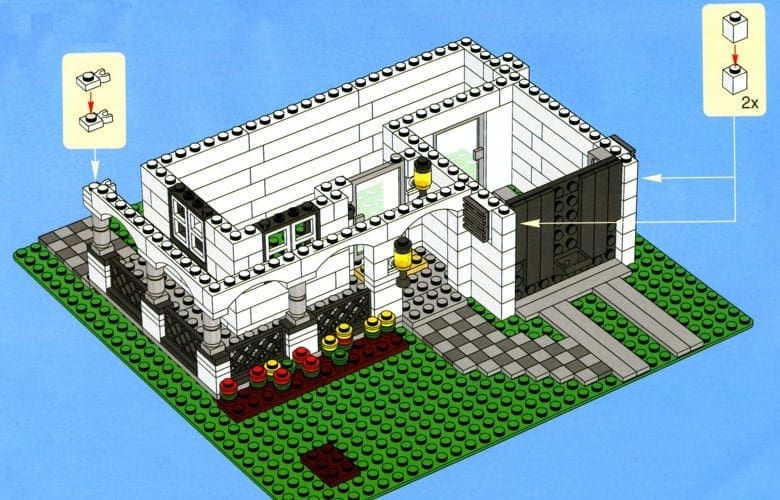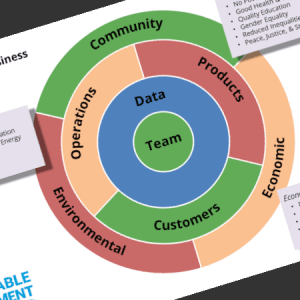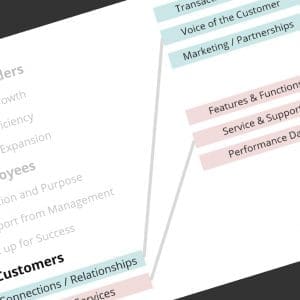The best companies are radically focused on a great customer experience. As your customer base shifts to a digital, mobile mindset, Customer Relationships needs to be part of your Great Digital Business. (Part of a series)
In my previous article in this series on the Five Core Components of a Great Digital Business, I talk about the data, process, and systems that drive internal operations. Quite possibly the most boring part of a digital business – decidedly unsexy, been around for ages, the electronic epitome of drudgery and toil.
But now let’s think about customer-facing, customer-centric processes, with their own collection of supporting systems and derived data. Quite possibly the most over-simplified part of digital business – it’s not as simple as building a web site or an app, spending time and money on design with no thought to supporting process.
<aside>Yes, I have written a lot about Design, and there is no doubt that it is an important part of the user experience, the employee experience, and the “stickiness” and usability of any process. Customer-facing systems are typically where Design gets the credit it deserves. But don’t oversell the importance of Design – it’s not the tail that wags this dog. </aside>
This customer-facing technology has been around for many years, part of the second impact wave of information and technology on business. In 2001, Porter wrote about how the Internet would enable a new level of connectivity between companies and their value chains (back to the supplier, out to the customer). Mass customization and the power of the consumer were big ideas, but they strained against the legacy of standardization and control from those monolithic ERPs.
And it is about this time in history that technology vendors are learning the value of bypassing IT to get to the real decision makers (Them That Owns The Budget) – for the good, as real progress was made for the customer. But these newly formed teams, with non-traditional technical backgrounds, often have trouble reconciling the need for engineering & control with the need for speed, flexibility, and a real focus on the customer. Is it surprising that, over time, these disconnected teams have built up disconnected processes and data pools?
Fast forward to present day – eCommerce and CRM projects have successfully established that a business can and should have a deeper, collaborative relationship with their customers. But transaction complexity and demand for flexibility increases as these systems have invaded a broader range of industries. The industrial world, for example, with highly engineered, highly variable products and services, brings a higher level of sophistication to the requirements for the individuals and the teams that are using these systems.
Platforms have changed as well – and I’m not talking about “the cloud”.
<aside> Which, by the way, is typically overhyped as a shift from capital + headcount to operating expense + services [true] which translates to speed [somewhat] and innovation [ok, now we are stretching it ] …</aside>
The bigger platform shift has been to mobile – with ubiquitous mid- to high-bandwidth data coverage (important) and the social shift to a reliance on smartphones and an expectation of integrated information. Customers are expecting / demanding a different kind of communication from their suppliers – how we inform and educate them (data rich and transparent – and subject to the crowd), transact with them (seamless, cashless, and secure) and support them (prescient, effortless, and timely).
Link to Digital Business
Most folks fully understand that customer-facing systems belong in your Great Digital Business – but what role should they play? And how will they interact with and leverage the data and process of the other components?
- Internal Operations: The transaction systems that fuel the core processes of Make to Ship are wonderful sources of rich data about your customers. Who is buying – specifically, who is placing the order? What is our performance record with them – are we on time or chronically late? What is the buying history (and patterns) of these customers? And how profitable are they – worth the expense required to keep serving them? That last one gets to the idea that some customers are better than others – or, certainly more profitable than others. And if that is what is important for your organization’s long-term health? Well, it’s a helpful thing to know.
- Products and Services: Another rich source of data to get a clearer picture of your customers. Where exactly are they using your product? How often? And are your products and services delivering the value promised? These touch points between you and your customers can be tracked, studied, and analyzed for those all-important customer insights, to help understand the value you bring, the problem you solve – and the future innovations you can bring to those same customers.
- Leveraging Information: You probably see the pattern here – the components of your Great Digital Business are extending the ecosystem of information, building a rich and detailed picture of your customers, their needs, demands, and their experience with your product and your team. An important part of any company’s mission will be their relationships with customers; leveraging the information gathered around these customers will generate tremendous value – if done correctly.
The Value in Tight Connections
Your customers are the life blood of your organization, and the best companies are radically focused on a great customer experience. As your customer base – really, the entire world – shifts to a digital, mobile mindset, maybe Customer Relationships is the natural place to start talking Digital Business.
But use this inroad as a first step, not the entire journey, to a strong Digital Reality.
One of a series on Digital Business; next up is Digital Business and Products …
.. but why wait to start the conversation? What are your questions or ideas on how systems and processes for Customers can be part of a Digital Transformation? Join in the conversation with your Comments …
23 January, 2017
- The Five Core Components of a Great Digital Business
- Digital Business and Internal Operations: Treasure in the Foundation
- Digital Business and Customer Relationships: Big Value in Tight Connections
- Digital Business and Products: Changing the Game in a Big Way
- Digital Business and Data: The Critical Connective Tissue
- Digital Business and Your Team: Talent and Engagement
- Start Here: 5 Building Blocks of an AI-Driven Business (and Why They Still Matter)
- 5 Building Blocks of an AI-Driven Business: Customer Connections at Machine Scale






Comments (0)